amjath
Disciple
Ethernet Cable/LAN Cable: An Ethernet cable is one of the most popular forms of network cable used on wired networks. Ethernet cables connect devices on local area networks such as PCs, routers and switches.
Types of Cables:
Basically there are 3 types of Cables.
1. Straight Through Cables
Straight-through cables are used for connecting unlike devices.
For example:
* Connecting a router to a hub
* Connecting a computer to a switch/router
* Connecting a modem to a router
2. Crossover Cables
Crossover cables are used for connecting like devices.
For example:
* Connecting a computer to a computer
* Connecting a router to a router
* Connecting a switch to a switch
* Connecting a hub to a hub
3. Rollover Cables
Rollover cable also known as Cisco console cable or a Yost cable used to connect a computer terminal to a router's console port. So basically it's not our purpose of using so just a little info will be available regarding it.
Ethernet cables Categories:
EBay has a very good and consolidated guide for Cable Categories/ Types.
So Choosing a "Cat 5E" cables is the best and economical type.
Materials to choose:
A crimping Tool:
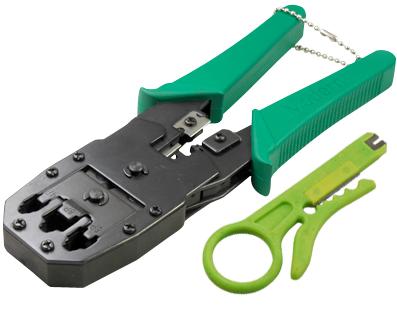
A cheaper crimping tool will do. Like the one below
Crimping Tool
A Ethernet Cable:
An Ethernet cable of your length [get a little lengthy, you may end up trial and error]
A RJ45 Plug/Jack
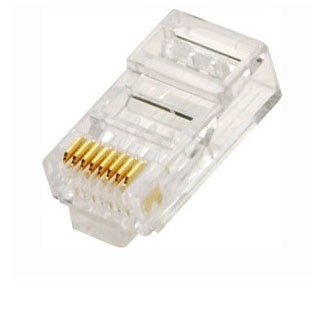
Get more than what u need because u may end up trial and error.
[Optional] LAN Cable Boot:
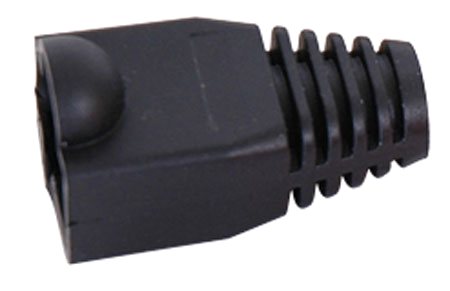
To protect wearing and tearing.
[Optional] LAN Cable Tester:
Personally I never used one, so I will not suggest which one to buy. Lots of low price testers are available in the market. So it's your choice.
Setting Up before Crimping:
1. Take your Ethernet Cable and strip the outer cover carefully so that you don't damage the inner wires.
2. You will find the 4 pair of wires twisted like this
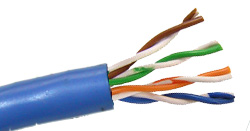
3. IMPORTANT: Do not strip the protective inner coating for 4 pairs like this
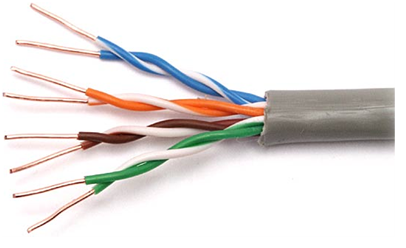
4. Unwind the twist between 4 pairs of the cable and align perfectly and cut off the edge using the cutting section of the crimping tool.
The cable should be ready to crimp like this
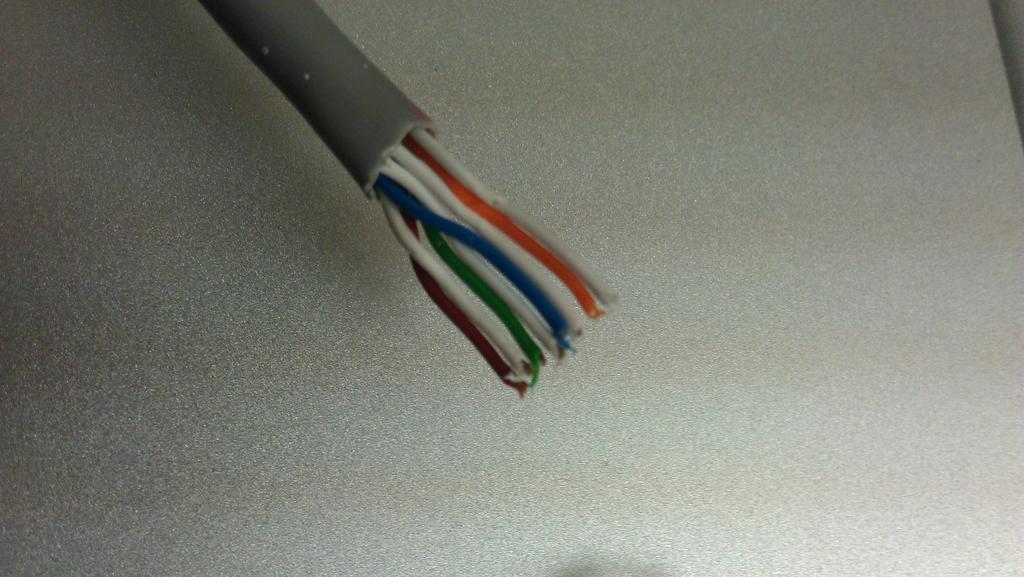
5. [Optional] Insert LAN Cable Boot on both sides.
Crimping a Straight through cable:
How does a Straight through cable looks like.
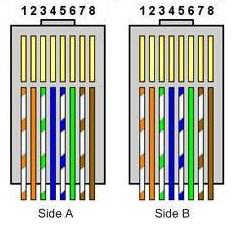
The above picture clearly explains that the coloured wires on both side of the jack should be same.
Take the cable which was properly cut from step 4 above and arrange the coloured wires correctly as mentioned in above picture.
Hold the cable and insert the 8 wires properly into 8 section of the Ethernet Jack
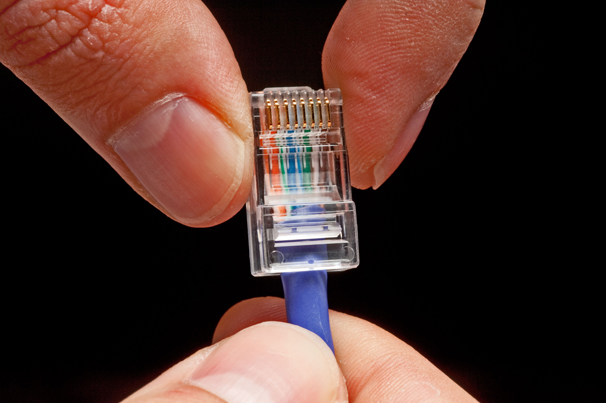
Insert the jack and wire combo into RJ45 port the crimping tool
Note: The crimping tool may come with additional ports for crimping telephone wires too.
Press the Crimping tool a bit harder so that the pin which are protruding from the jack

should not be protruding after crimping.
So now we crimped one side of the cable.
on the other side of the cable, the colour combination used on one side should be the same on the other side too. So follow method to crimp the other side. Now your straight through cable is for ready. You can test your cable using " LAN Cable Tester" too.
Crimping a Crossover cable:
How does a Crossover cable looks like.
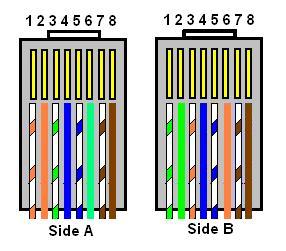
Look closely. Observe that 2 pairs of wires are in same position and other two pair is crossed.
The wires in the lead 4, 5 ,7 and 8 are same on both sides and 1, 2, 3 and 6 wires are crossed.
Take the cable which was properly cut and arrange the coloured wires correctly as mentioned in above picture.
Hold the cable and insert the 8 wires properly into 8 section of the Ethernet Jack

Insert the jack and wire combo into RJ45 port the crimping tool
Note: The crimping tool may come with additional ports for crimping telephone wires too.
Press the Crimping tool a bit harder so that the pin which are protruding from the jack

should not be protruding after crimping.
So now we crimped one side of the cable.
on the other side of the cable, the colour combination used on one side should be the same on the other side too. So follow method to crimp the other side. Now your straight through cable is for ready. You can test your cable using " LAN Cable Tester" too.
Crimping a Rollover Cables:
Just the image for this type since we may not use this type. So Just read the below image.
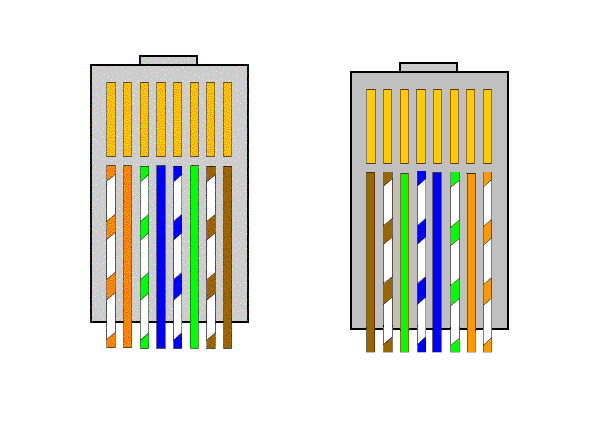
Let me via PM if u find any mistakes or any additional information to be added to this thread. Thank you. Hope I helped somewhat.
If anyone find it's a TL;DR
Buy a crimped cable.
Update:
Newer PC's/Motherboard have a built in feature called Auto-MDIX (Medium Dependant Interface Crossover).
So a straight through cable or a crossover cable can be used for PC-PC connection.
The Auto-MDIX enabled devices will reconfigure itself so that even Straight through cables can also be used for PC-PC Connection. Same for Like devices too since modern devices auto senses the connection type and cables
Types of Cables:
Basically there are 3 types of Cables.
1. Straight Through Cables
Straight-through cables are used for connecting unlike devices.
For example:
* Connecting a router to a hub
* Connecting a computer to a switch/router
* Connecting a modem to a router
2. Crossover Cables
Crossover cables are used for connecting like devices.
For example:
* Connecting a computer to a computer
* Connecting a router to a router
* Connecting a switch to a switch
* Connecting a hub to a hub
3. Rollover Cables
Rollover cable also known as Cisco console cable or a Yost cable used to connect a computer terminal to a router's console port. So basically it's not our purpose of using so just a little info will be available regarding it.
Ethernet cables Categories:
EBay has a very good and consolidated guide for Cable Categories/ Types.
- Cat 3 - Older networks worked with Cat 3 cable and this type of cable is no longer readily available. It supports 16 MHz bandwidth, 10 Mbps Ethernet connections, and can be used for voice and telephony.
- Cat 5 - Cat 5 cable is backwards compatible with Cat 3 applications, but supports 100 MHz bandwidth and 10/100 Mbps Ethernet connections.
- Cat 5 E - Cat 5E is the enhanced version of Cat 5 and is most common. However, with constant increases in internet speeds, Cat 5E is becoming a budget option. Cat 5E helps to prevent electromagnetic interference and can support Ethernet connections of 10/100/1000 Mbps, and 100 to 400 MHz bandwidth. 1000 Mbps Ethernet is also known as Gigabit Ethernet. All four wire pairs in the cable are used.
- Cat 6 - Cat 6 cables are backwards compatible with all other cables. They are like Cat 5E cables, but have larger gauge wires and work for Ethernet connections up to 10 Gbps. They support up to 250 MHz bandwidth. Cat 6 cables were developed with Gigabit Ethernet in mind. Those who are upgrading their network cables should consider installing Cat 6 as this will eliminate the need to upgrade again in the near future. When installing cables for 10Gbps Ethernet, Cat 6 cables can be used over distances of up to 185 feet, but Cat 6a should be used for distances up to 300 feet.
- Cat 7 - Cat 7 cabling is also known as Class F. This fully shielded variety supports bandwidths of up to 600 MHz, but is not used for home networking.
So Choosing a "Cat 5E" cables is the best and economical type.
Materials to choose:
A crimping Tool:

A cheaper crimping tool will do. Like the one below
Crimping Tool
A Ethernet Cable:
An Ethernet cable of your length [get a little lengthy, you may end up trial and error]
A RJ45 Plug/Jack

Get more than what u need because u may end up trial and error.
[Optional] LAN Cable Boot:

To protect wearing and tearing.
[Optional] LAN Cable Tester:
Personally I never used one, so I will not suggest which one to buy. Lots of low price testers are available in the market. So it's your choice.
Setting Up before Crimping:
1. Take your Ethernet Cable and strip the outer cover carefully so that you don't damage the inner wires.
2. You will find the 4 pair of wires twisted like this

3. IMPORTANT: Do not strip the protective inner coating for 4 pairs like this

4. Unwind the twist between 4 pairs of the cable and align perfectly and cut off the edge using the cutting section of the crimping tool.
The cable should be ready to crimp like this

5. [Optional] Insert LAN Cable Boot on both sides.
Crimping a Straight through cable:
How does a Straight through cable looks like.

The above picture clearly explains that the coloured wires on both side of the jack should be same.
Take the cable which was properly cut from step 4 above and arrange the coloured wires correctly as mentioned in above picture.
Hold the cable and insert the 8 wires properly into 8 section of the Ethernet Jack

Insert the jack and wire combo into RJ45 port the crimping tool
Note: The crimping tool may come with additional ports for crimping telephone wires too.
Press the Crimping tool a bit harder so that the pin which are protruding from the jack

should not be protruding after crimping.
So now we crimped one side of the cable.
on the other side of the cable, the colour combination used on one side should be the same on the other side too. So follow method to crimp the other side. Now your straight through cable is for ready. You can test your cable using " LAN Cable Tester" too.
Crimping a Crossover cable:
How does a Crossover cable looks like.

Look closely. Observe that 2 pairs of wires are in same position and other two pair is crossed.
The wires in the lead 4, 5 ,7 and 8 are same on both sides and 1, 2, 3 and 6 wires are crossed.
Take the cable which was properly cut and arrange the coloured wires correctly as mentioned in above picture.
Hold the cable and insert the 8 wires properly into 8 section of the Ethernet Jack

Insert the jack and wire combo into RJ45 port the crimping tool
Note: The crimping tool may come with additional ports for crimping telephone wires too.
Press the Crimping tool a bit harder so that the pin which are protruding from the jack

should not be protruding after crimping.
So now we crimped one side of the cable.
on the other side of the cable, the colour combination used on one side should be the same on the other side too. So follow method to crimp the other side. Now your straight through cable is for ready. You can test your cable using " LAN Cable Tester" too.
Crimping a Rollover Cables:
Just the image for this type since we may not use this type. So Just read the below image.

Let me via PM if u find any mistakes or any additional information to be added to this thread. Thank you. Hope I helped somewhat.
If anyone find it's a TL;DR
Buy a crimped cable.
Update:
Newer PC's/Motherboard have a built in feature called Auto-MDIX (Medium Dependant Interface Crossover).
So a straight through cable or a crossover cable can be used for PC-PC connection.
The Auto-MDIX enabled devices will reconfigure itself so that even Straight through cables can also be used for PC-PC Connection. Same for Like devices too since modern devices auto senses the connection type and cables
Last edited:

